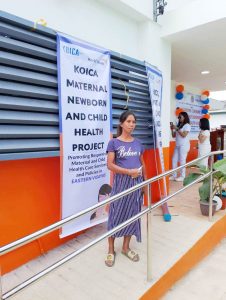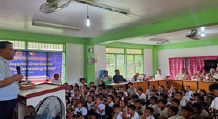Funded by World Vision and KOICA
BY: JOEY A. GABIETA
SILVINO LUBOS, Northern Samar – Joan Silvestre, a 33-year-old mother, is preparing to give birth to her sixth child next month, but this time, she will do so in the newly-rehabilitated health center of Silvino Lubos.

In a town where instances of maternal and infant mortality are alarmingly common, the inauguration of the health center brings hope for safer deliveries.
Silvestre, who previously opted for home deliveries due to the remoteness of her village, expressed her happiness and anticipation for a safe delivery at the new health center.
“Our village is very remote. We have to trek for at least three hours just to reach the poblacion. And if the weather is bad, we have to travel by boat for almost an hour,” she explained.
The one-story facility, funded by World Vision Philippines and the Korea International Cooperation Agency (KOICA) at a cost of P8.27 million, was formally inaugurated on Saturday (March 2) with health officials from the region and province in attendance.
Dr. Ma. Aurora Vicencio, the provincial health officer, emphasized that the newly rehabilitated health center represents more than just a building; it is a beacon of hope for addressing maternal and childcare issues in the municipality, which is home to over 16,000 residents.
Despite the challenges posed by remote villages like Geparayan de Turag, where Silvestre resides, the health center offers a safer alternative to home deliveries facilitated by local midwives or ‘hilots’.
Dr. Joan Siervo, the municipal health officer, highlighted the risks associated with home deliveries, including the lack of immediate vaccination for newborns and monitoring for potential complications.
“Newborn babies require immediate vaccination, which they don’t receive if delivered by a ‘hilot.’ Both the babies and their mothers need to be monitored for potential complications like bleeding,” she explained.
To encourage pregnant mothers from remote villages to utilize the facility, the local government has established a halfway house where expectant mothers and their partners can stay a week before delivery, with free food supply provided.
In addition to infrastructure improvements, local ordinances have been passed to regulate traditional birthing practices and promote safer deliveries. However, enforcement remains a challenge due to the town’s dispersed barangays.
Mothers who could complete prenatal checkups are also to receive P8,000 from the municipal government as an incentive.
World Vision Philippines, in collaboration with the Philippine government and local health authorities, aims to address gaps in maternal and childcare delivery.
Bonifacio Calapan, the operations director, emphasized the importance of prioritizing the health of pregnant women for the well-being of future generations.
“They are the future of our nation. We must prioritize the health of pregnant women because the health of the child and the nation begins with them,” he stressed.
Jihwan Jeon, the project director of World Vision Philippines, echoed Calapan’s sentiment, emphasizing their collaboration with the Philippine government, local government, and the Department of Health to address gaps in maternal and child care delivery.
“Our goal is to ensure that no one is left behind in terms of healthcare,” he added.
Mayor Leo Jarito expressed gratitude for the renovation of the health facility, which now operates as a mini-hospital equipped to provide medical services and facilitate safe deliveries for pregnant mothers.
With modern facilities and round-the-clock staffing, the health center aims to encourage more mothers to utilize its services, ultimately reducing maternal and infant mortality rates in the region.



